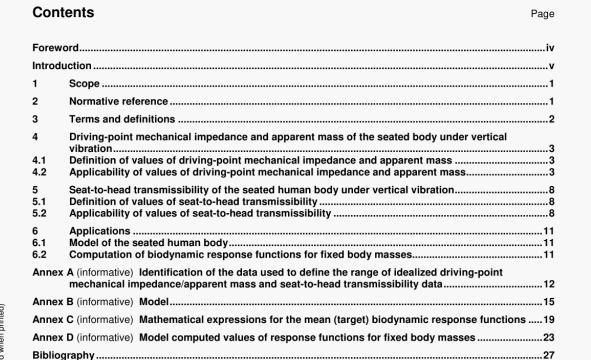ISO 5982 pdf download – Mechanical vibration and shock -Rangeof idealized values to characterize seated-body biodynamic response under vertical vibration.
5.1 Definition of values of seat-to-head transmissibility
The modulus and phase of the seat-to-head transmissibility of the seated body are given in Table 3 and (for illustration) in Figure 3 as a function of frequency, for the vertical direction of excitation. In accordance wilt) the definition, the modulus is non-dimensional and represents the ratio of acceleration transmitted to the head to the acceleration measured at the butlocks. The table and diagram contain three values of modulus and phase at each frequency. Numerical values are quoted up to three significant figures for the purpose of calculation, and do not reflect the precision of knowledge of the seat-to-head transmissibility. Linear interpolation is permitted to obtain values at frequencies other man those listed in Table 3 at one-third-octave band centre frequencies.
The upper and lower limiting values at each one-third-octave band centre frequency encompass the mean values of all data sets selected, and are shown by bold continuous curves in Figure 3 The central value at each frequency. shown by fine solid curves in Figure 3, provides an estimate of the weighted mean of all data sets selected, and forms the target value lot all applications. The standard deviahons computed with respect to the weighted mean (target) values are also listed in Table 3
Applications mat generate-employ values of seat-to-head transmissibility between the upper and lower limits given in Table 3 at any frequency satisfy the requirements of this International Standard, and represent through the body transfer functions applicable to the seated human body under the conditions specified and over the frequency range of 0,5 Hz to 20 Hz.
If an application only satisfies the requirements of this International Standard at certain frequencies, then those frequencies should be stated in any description of the application.
NOTE 1 The curves in Figure 3 are derived from the data stenbfied ii annex A low seal to-head tranamissety The synthesis is performed by averaging once the rstMdual data sets have been weighted according to the popiAation of subjects involved in deriving the data. Liper and lower uniting values represent maximum and minimum values of the data sets delemiined at each frequency.
NOTE 2 The curves in FIgure 3 relate to 32 test subjects within the mass range 56 kg to 90 kg. The maonty of data sets have been produced under sinusoidal vibration at frequencies lower than 20Hz and for r.m.s. unweighted acceferabons lower than 5 mis2. Head acceleration was measured using a bite bar technique for most data sets involved in the data synthesis. Furthermore, some data sets ongeate from sb.ides In Midi the teat were trisupported. Current evidence suggests that seat-to- head transmissibility is not likely to be influenced in any significant manner by the inclusion or not of toot support provided that the leg p054 ion is the same.
NOTE 3 Seat-to-head transnsssibility data have often been produced using vibration excitations at levels which tended to be considerably higher than those used tow diivingpoint mechanical impedance and apparent mass Increased sensitivity to posture and backrest support rmght have been responsible for the wide vanability observed amongst various data sets reported by different investigators.
NOTE 4 There is at present limited evidence to suggest that the seatto-head transimssibility modub,js shown in Figure 3 could pethaps provide overestimations at the values to be appeed In cases involving vibration excitations of sinstar amplitudes but characterized mostly by narrow-band tow-frequency vibration containing shocks.
52 Applicability of values of seat-to-head transmissibility
The values of seat-to-head transmissibility are applicable to the seated human body subjected to sinusoidal or broad-band random venlical vibration, while seated on a rigid surface whit the back being unsupported. Both conditions of feet being supported on a vibrating platform and hanging freely are integrated for the purpose of defining seat-to•head transmissdility. The limits of applicability approximately correspond to the range of measurement conditions over which data were obtained, as follows:
a) the posture is described as erect seated without backrest support, while the feet may be supported or not;
b) the mass of the subjects ranges from 56 kg to 90 kg;
C) the unweighted rms. amplitude of sine and broad-band random excitation is between I m/s2 and 5 m/s, with a higher proportion of subjects submitted to sinusoidal rather than to random vibration over the frequency range from 0,5 Hz to 20 Hz.
ISO 5982 pdf download – Mechanical vibration and shock -Rangeof idealized values to characterize seated-body biodynamic response under vertical vibration
